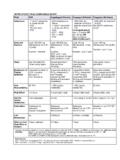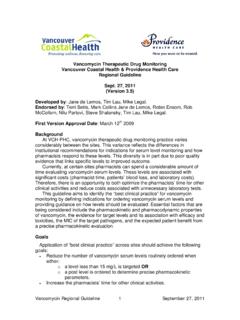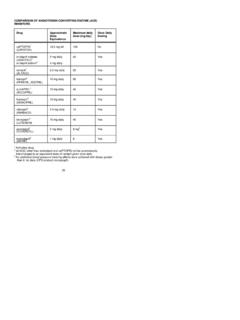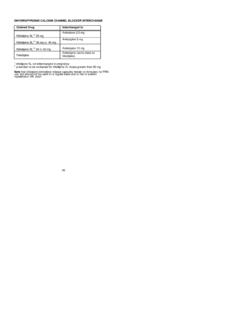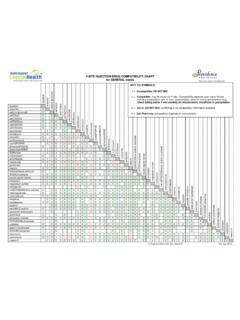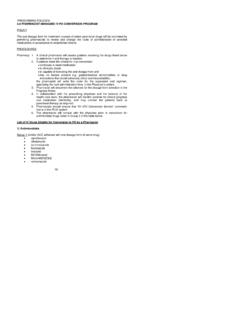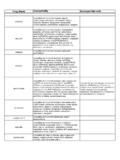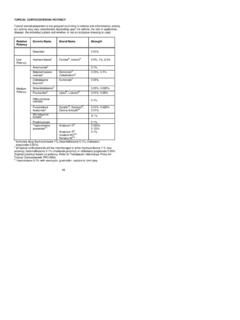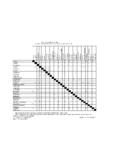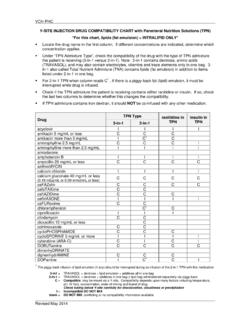Transcription of Drug-Induced Acute Renal Dysfunction
1 Drug-Induced Acute Renal DysfunctionKaren shalansky , Specialist, VGHC linical Professor, UBCApr 8, 2010 Outline Pseudo Renal Failure Acute Renal Failure Prerenal NSAIDs, CyA/Tacrolimus, ACEI/ARB, Diuretics Intrinsic ATN vs AIN ATN Aminoglycosides, Amphotericin B, Radiocontrast Media Obstructive Methotrexate, Acyclovir, Indinavir, Rhabdomyolysis (Statins)Pseudo Renal Failure BUNdue to protein catabolism Steroids, tetracyclines SCrdue to competitive inhibition of creatinine secretion Trimethoprim, Cimetidine, Triamterene Trimethoprim 15-35% rise SCr fully expressed after 3 days More sig in pts with pre-existing Renal Dysfunction Can occur with normal doses Completely reversible when drug is discontinued(J Int Med 1999l246:247-52; TDM 1987;9:161-5) Acute Renal Failure: PRE- Renal ACEI/ARB NSAIDs Diuretics Immunosuppressives (CyA, Tacrolimus)Case: ACEI and Renal Failure Case 1: 52 yo male with Type 2 DM baseline creatinine 159umol/L; BP 148/92 Ramipril 5 mg daily started and 2 weeks later: BP 138/82 Serum creatinine 194umol/L Case 2: 82 yo female with osteoarthritis Admitted to hospital for CAP & dehydration Meds: Losartan 100mg daily + Naproxen 250mg BID Serum creatinine 250 umol/LAm J Kidney Dis 2009.
2 53:332-45 Non-ACE Pathways ( chymase, cathepsins)ACEI/ARB PathwayACEI/ARB and the KidneyAfferent arterioleEfferent arterioleGlomerulusUrineAngiotensin II vasoconstrictsefferent arteriole Glomerular Capillary Pressure Permeability ProteinuriaRenal Protective Properties of ACEI/ARBA fferent arterioleEfferent arterioleGlomerulusUrineACEI/ARBB enefits of ACEI/ARB: decreased intraglomerularpressure and reduction of proteinuriaPathogenesis of ARF with ACEI/ARBA fferent arterioleEfferent arterioleGlomerulusUrineACEI/ARBR enal function becomes dependent on sustained constriction of efferent arteriole from angiotensin IIAfferent Arteriolar Vasoconstrictors: Vasodilatory PG Inhibitors: NSAIDsDirect Afferent Vasoconstrictors: CyA, Tacrolimus, RadioconstrastMedia, VasopressorsEfferent Arteriolar Vasodilators: RAAS: ACEI, ARB Direct Efferent Vasodilators: Diltiazem, VerapamilRisk Factors for ARF with ACEI/ARB Decreased intravascular volume (dehydration, diuretic overuse, CHF, vomiting, diarrhea) Use of afferent vasoconstrictor agents (NSAIDs, cyclosporine, tacrolimus) Sepsis Renal -artery stenosis Polycystic kidney diseaseOptimal Use of ACEI/ARB(NEJM 2002;347:1256-61, Arch Int Med 2000.)
3 160:685-93)Case 1: Creatinine 159 to 194 in 2 weeks accept 20-30% increase in serum creatinine within 1-2 months of initiation in fact, this could be an indication that the drugs are exerting their desired actions to help preserve Renal function check serum creatinine 1-2 weeks after initiation, then in 2-4 weeks if > 30% change, decrease ACEI/ARB dose by 50% and repeat Ser Cr in 4 weeks (exclude hypovolemia/NSAIDs, etc) if > 50% rise in Ser Cr rule out RAS repeat serum creatinine in this patient in 1-2 weeks to ensure it has stabilizedOptimal Use of ACEI/ARBCase 2: Creatinine on admission 250 umol/L in patient with CAP and dehydration discontinue NSAID and hold ARB until infection treated and patient is rehydrated/creatinine reduced resume ARB and monitor serum creatinine NSAIDs/COX II Inhibitors Case # 2: Physician would like to switch previous patient from Naproxen to Celecoxib Are Cox II inhibitors less likely to cause Acute Renal failure compared to NSAIDs?
4 1414 Arachidonic AcidProstanoids Prostanoids (Prostacyclin)(Prostacyclin)ProstanoidsP rostanoids(Thromboxane A2)(Thromboxane A2)Protection of Gastric MucosaProtection of Gastric MucosaPlatelet AggregationPlatelet AggregationPain, Inflammation, FeverPain, Inflammation, FeverInhibits Platelet AggregationInhibits Platelet AggregationRenal EffectsRenal EffectsGastropathy andAntithrombotic EffectsEffects on Na+BalanceAnti-inflammatory and Analgesic EffectsProthrombotic EffectsNSAIDsCOXCOX--22 COXCOX--11CO2 HSelective COX-2 InhibitorsCOX-1 and COX-2 Hypothesis (1992)ConstitutiveInducibleNote: ASA has an irreversible effect, while other NSAIDS are competitive--33--22--1100112233ketorolac ketorolacIn Vitro Selectivity: COX-2/COX-1 Ratioflurbiprofenflurbiprofenibuprofenib uprofentolmetintolmetinnaproxennaproxena spirinaspirinindomethacinindomethacinket oprofenketoprofenfenoprofenfenoprofenrof ecoxibrofecoxibetoricoxibetoricoxibvalde coxibvaldecoxibdiclofenacdiclofenacmelox icammeloxicamcelecoxibetodolacetodolacsu lindacsulindac> 50> 50--fold COXfold COX--2 selective2 selective55--5050--fold COXfold COX--2 selective2 selective< 5< 5--fold COXfold COX--2 selective2 selectiveRange of COX Selectivity for COXR ange of COX Selectivity for COX--1 and COX1 and COX--2 2 log(IClog(IC8080 COXCOX--2/1)2/1)Increasing COXI ncreasing COX--2 Selective2 SelectiveIncreasing COXI ncreasing COX--1 Selective1 SelectivelumiracoxiblumiracoxibAdapted from: Warner et al.
5 FASEB J. 2004:18:790-804 NSAIDs/COXibs Use with caution in CKD (grade 3 or greater) Inhibit Renal vasodilatory prostaglandins E2 & I2 Produced by COX-2 Reversible reduction in GFR Higher risk if intravascular volume depletion Management: D/C drug , use alternate analgesia Hypertension Edema, sodium and water retention Mean increase SBP 5 mm Hg Hyperkalemia Risk blunting of PG-mediated renin releaseCyclosporine, Tacrolimus Can cause pre- Renal (hemodyanamicallymediated) or chronic interstitial nephritis Pre- Renal dose-related preglomerular arteriolar vasoconstriction or direct proximal tubule damage SCr ~ 30% More common in first 6 mos of therapy Hypertension, K, Mg may occur Reversible with lowering dose (caution rejection) Monitor blood levels Renal biopsy to distinguish Acute CyAnephrotoxcity from allograft rejectionAcute Renal Failure:INTRINSICA cute Interstitial Nephritis (AIN) vsAcute Tubular Necrosis (ATN)History, exam, lab, urineRenal biopsy gold standardDiganosisAnti-infectives: A/G, Vanco, AmphoB, Sulfa; Contrast Media, CisplatinAnti-Infectives: Beta-lactam, Sulfa, Rifampin, Ciprofloxacin; Other: NSAIDs, PPI, Cimetidine, Allopurinol, Phenytoin, DiureticsCommon DrugsD/C offending agent (can be dose-related)D/C offending agent (not dose-related); if persists: Prednisone**TreatmentUsually reversible and GFR return to BL in 7-14dRF should begin to recover ~7d; May have residual CKD 36-40%Time CourseGranular casts, Renal epithelial casts; oliguria, FENaWBC casts, eosinophiluria, hematuria, mild proteinuria*, oliguriaUrinalysisUremic SymptomsClassic Triad: Fever, Rash (50%), eosinophilia (> 75%)*Clinical FeaturesEarly (7-10 days)1stexposure: > 10-14days*2ndexposure: 3-5 daysOnsetATNAIN*NSAIDs - onset 2-3mos; noeosinophilia/uria, fever or rash; proteinuria > 3g/24h.
6 **Reserve if delayed Renal recovery (> 1 wk), prolonged exposure to agent (> 2-3 wks) ATN: Aminoglycosides Incidence 5-20% Onset Gradual SCr after 5-10 days Pathogenesis Tubular epithelial cell damage leading to obstruction of tubular lumen Presentation Non-oliguria > 500mL/day; granular casts in urine Risk Factors Combination therapy with other nephrotoxic drugs Total cumulative dose; trough levels > 2 mg/L; repeated courses of A/G therapy; prolonged therapy > 10 days Dehydration Management Reversible if D/C drug , adequate hydration, monitor levelsATN: Aminoglycosides Is once daily dosing less nephrotoxiccompared to traditional dosing?Once Daily A/G Dosing: mg/kg Q24H (eGFR >60 mL/min) Theory why once daily A/G therapy works: Concentration-dependent kill (10x MIC) Post-antibiotic effect Exclusion Burns > 20%, Septic Shock, Synergy GFR < 60 mL/min, Dialysis Potential for reduced nephrotoxicity Proximal tubular A/G update appears to be limited during transient, high-peak serum levels Low A/G concs for a greater proportion of dosing interval facilitate excretion of A/G Nephrotoxicty Only 1/4 meta-analyses showed reduced nephrotoxicity(from to ); rest showed no differenceATN: Amphotericin B Incidence: ~80% when cumulative dose reaches 2 g Pathogenesis Direct tubular epithelial cell damage; binds to cell wall resulting in tubular permeability and necrosis Presentation SCr, BUN, Mg, K (urinary wasting) monitor q1-2d Distal RTA, polyuria (nephrogenic DI) Risk Factors Combination therapy with other nephrotoxic drugs Total cumulative dose.
7 Daily dose > Dehydration Management Reversible if D/C drug , Hydration (1L NS daily)ATN: Amphotericin B Are Liposomal formulations less nephrotoxiccompared to traditional Amphotericin B deoxycholate?Liposomal Amphotericin B Theory for reduced nephrotoxicity Reduced nephrotoxicity by enhancing the delivery to sites of infection, thus reducing exposure to mammalian cell membranes Cochrane review April 2000 all lipid-based preps decreased the occurrence of nephrotoxicity AKI still occurs, esp if concurrent exposure to other nephrotoxic drugs Amphotericin B deoxycholate vs Liposomal VGH guidelines: only prescribe Ampho B if GFR > 50mL/min and low risk for Renal failure Drawback Liposomal -Very expensive($440-735/day)Alternatives to Liposomal Ampho Invasive aspergillosis Voriconazole(~$100 PO; ~$400 IV) Cannot use IV voriconazole if GFR < 50 mL/min due to accumulation of vehicle CYP2C9 and 3A4 inhibitor ( CyA, Methadone, statins, tacrolimus, vincristine, warfarin Invasive candidiasis Fluconazole 1stline for uncomplicated pts ($20/day) CYP 2C9 inhibitor ( warfarin, phenytoin) Echinocandin (micafungin -$50/day) for complicated pts (neutropenic, unknown Candida isolates, hemodynamicallyunstable, recent azoles) may CyA, sirolimusATN: Radiographic Contrast Media Incidence: 40-50% in high risk pts (CKD, DM) Onset: within 12-24 hrs, SCr peaks 2-5 days after exposure, recovery usually after 4-10 days Pathogenesis Direct tubular necrosis, Renal ischemia Presentation Typically non-oliguric (high risk may require HD) Urinalysis hyaline and granular casts, low FENa Risk Factors: DM, CKD, prestudy dehydration Management Low-osmolality nonionic contrast agents (eg.))
8 Iohexol), smallest dose, HydrationInterventions to Prevent Contrast Nephrotoxicity Which is best proven prevention strategy?oNS 1-2 mL/kg/hr starting 12 hours pre and continued 12 hours post-procedureoSodium Bicarbonate 150mEq/L D5W infused at 3mL/kg/h x 1 hours pre, then 1mL/kg/h x 6 hours post-procedureoN-acetylcysteine 600mg PO BID x 4 doses on day prior to and on day after admin of contrastB-1600mg PO BID x 4 doses pre and postAcetylcysteineB-2(JAMA 2004)3mL/kg/h 1 hour prior to contrast exposure, then 1mL/kg/h for 6 hours post contrastSodium Bicarbonate 150 mEq/L D5WA-11mL/kg/h up to 150mL/h pre and post contrast exposureNormal SalineA-2 Avoid concurrent use of potentially nephrotoxic drugs ( NSAIDs, A/G)MedicationsA-1A-2A-2 Minimize contrast volume/dose Use noniodinated contrast studies Use low-osmoloar contrast agentContrastGradeaRecommendationInterve ntionRecommended Interventions for Prevention of Contrast Nephrotoxicity(DiPiro Pharmacotherapy 2009)aStrength of Recommendation A, B, C (Good, Moderate, Poor) Quality of Evidence.
9 1 (R, Controlled), 2 (R, Cohort), 3 (Expert opinion) Acute Renal Failure:Obstructive Nephropathy Statins: Rhabdomyolysis, Tumor Lysis Syndrome Crystalluria: Methotrexate, Suphonamides, Acyclovir, IndinavirARF: Obstructive Nephropathy Rhabdomyolysis Intratubular precipitation of myoglobulin Reddish-brown urine Statins: simvastain, atorvastatin risk edwith Cyp3A4 inhibitors (clarithromycin, erythro, itraconazole) orcombination fibrate Prevention Hold Statinwhile on clarithro/erythro or itraconazole therapy (alternative azithromycin OK) Pravastatin, Rosuvastatinnot metabolized by CYP 3A4 Drug-Induced Crystalluria drug insoluble in urine and crystallizes in distal tubule Risk Factors: Decreased circulating volume High concentration of drug in tubular fluid Prolonged intratubular transit time Renal Dysfunction amount of drug excreted per functioning nephron Acid or alkaline urine pH Prevention: Dosage adjustment for underlying Renal failure Volume expansion to enhance urinary output Urinary alkalinization (for weak acids) Full Renal Recovery expectedARF: Drug-Induced Crystalluria( drug insoluble in urine and crystallizes in distal tubule) Methotrexate Weak Acid precipitates in acidic urine (pH < 7) Precipitation of MTX and its metabolite in Renal tubules High dose MTX (12-15g/m2) Prevention Diuresis U/O 100-200mL/h x 24h post-high dose MTX Urinary alkalinization(sodium bicarb 25-50 mEq/L hydration fluid) Acyclovir Weak acid and weak base Intratubular precipitation of acyclovir in dehydrated oliguric patients Needle-shaped crystals Risks/Prevention IV too fast infusion rate Infuse over 1 hour High dose > 500mg/m2 Dehydration IV NS Pre-existing Renal failure adjust dose Other nephrotoxinsARF.
10 Drug-Induced Crystalluria Indinavir Protease inhibitor for HIV Weak base - precipitates in alkaline urine Crystal nephropathy (8%) dysuria, urinary freq Rectangular crystals Risk/Prevention Severe volume depletion Precipitation prevented by consumption of ~2 L fluid per day Sulphonamides Weak Acid precipitates in acidic urine Higher doses More common with sulfadiazine Risk/Prevention Volume depletion -maintain good fluid intake Renal Dysfunction -adjust dose Urinary alkalinization(treatment)Tips: Reducing Drug-Induced ToxicitiesCaution if GFR < 30-60 mL/minute ARF, K, hypertensionesp if patient on ACEI or diureticsNSAIDsDosage adjustment; 100mg/day max in Stage 5 (dialysis)Allopurinol Renal clearance potential for hypoglycemiaInsulinDo not use if GFR < 30-60 mL/min lactic acidosisMetforminChlorpropamide ed half-life, prolongs hypoglycemiaGlyburidehas active metabolite - t1/2 hypoglycemiaGliclazidepreferred agent no active metabolite (needs SA) (glyburide 5mg = gliclazide 80mg = gliclazide MR 30mg)SulfonylureasMeperidinemetabolite (normeperidine) is neurotoxic and may cause seizures C/I GFR < 50 mL/minFentanyl and Methadonepreferred for chronic pain management as no active metabolitesHydromorphonepreferred over Morphine (less 3-glucuronide metabolite - myoclonus, hallucinations)OpioidsReferences Guo X, Nzerue C.
